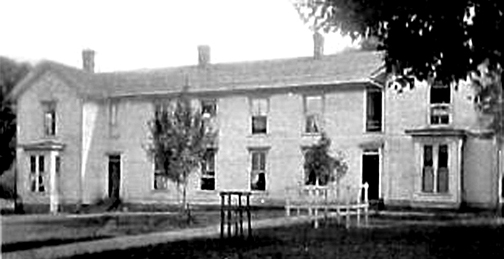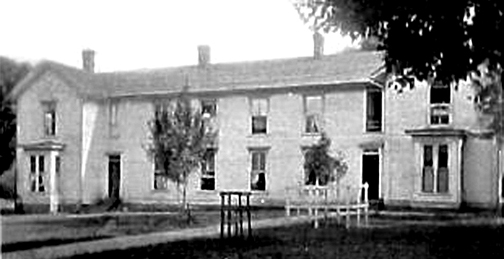A 1909 newspaper clipping speaks of a “serene section of East Tennessee lying beyond the Watauga River near the base of the loftiest mountains east of the Rockies.” The article states that no purer air or more lovely scenery could be found than the local region affords. It became immortalized after Bob Taylor expressed it in his writing and speeches as “Happy Valley.”
At the entrance to the valley, about a mile from Senator Taylor’s birthplace and only a stone’s throw from the present home of Alf Taylor, his brother and political competitor, stood Milligan College. It was the Alma Mater of both Bob and Alf and scores of other men who achieved future prominence.

Milligan College Young Ladies Home
Surrounded by a thick grove of maple trees, the old campus seemed to fit in naturally as an integral part of the landscape. Nature was observed here at its finest with Milligan College as its favorite shrine. According to the school’s early catalogue, Milligan was devoted to character building as its number one priority. No better place for such an institution could be found than in the healthy environment of Happy Valley.
Around the turn of the century, student enrollment was averaging from 175 to 250 students for the school year. In 1909, 213 students signed up for classes bringing expectations that the number could total 250 to 300 classmates by year-end. Immediate concerns were housing. A new brick dormitory, completed in 1908, became filled with students, prompting school officials to petition the board of trustees for more housing.
In 1881, the founding school, known as the Buffalo Male and Female Institute, was elevated to collegiate level through the efforts of Dr. Josephus Hopwood and renamed Milligan College after a favorite former teacher of his.
Prior to the Civil War, educational needs between the North and the South differed greatly. In the majority of the Northern States, social rank did not exist; settlers lived together in small farms clustered within a village. Each village eventually acquired a school.
In the South, the manner of living was substantially different. Each landowner had a sizable tract of land causing neighbors to be located miles apart. Often, it took one property-owner the better part of a day on horseback to reach the dwelling of another. Thus the country had no clustered towns like the North. There were many plantations stretched over a sparsely settled area of country. It was impossible for the South to have “town schools” as they were known in New England.
The Civil War did much to rearrange social conditions. The breaking up of the large plantations into many smaller homes, the freeing of slaves and passage of compulsory education laws created an efficient network of public schools. The natural noble pride of the South led to the establishment of a large number of private schools such as Milligan, many of which became phenomenally successful.
In. 1909, a general education law was passed that provided 25% of the gross state revenue to be devoted to the cause of education. Milligan was one of 19 state colleges that became recipients of proceeds:
University of Nashville (1785), The University of Tennessee (1794, Knoxville), Washington and Tusculum College (1794, Greenville), Maryville College (1819, Maryville), Cumberland University (1842, Lebanon), Burritt College (1848, Spencer), Hiwassee College (1849, Sweetwater), Bethel College (1850, Mackenzie), Carson and Newman College (1851, Jefferson City), Walden University (1866, Nashville), Fisk University (1866, Nashville), University of Chattanooga (1867, Chattanooga), University of the South (1868, Sewanee), King College (1869, Bristol), Christian Brothers College (1871, Memphis), Knoxville College (1875, Knoxville), Milligan College (1881, Milligan), Southwestern Presbyterian College (1885, Clarksville) and Lincoln Memorial University (1895, Cumberland Gap/ Harrogate).

Comments are closed.